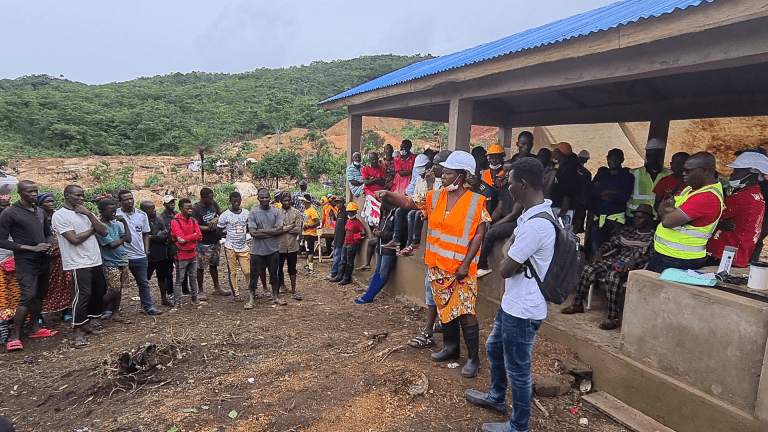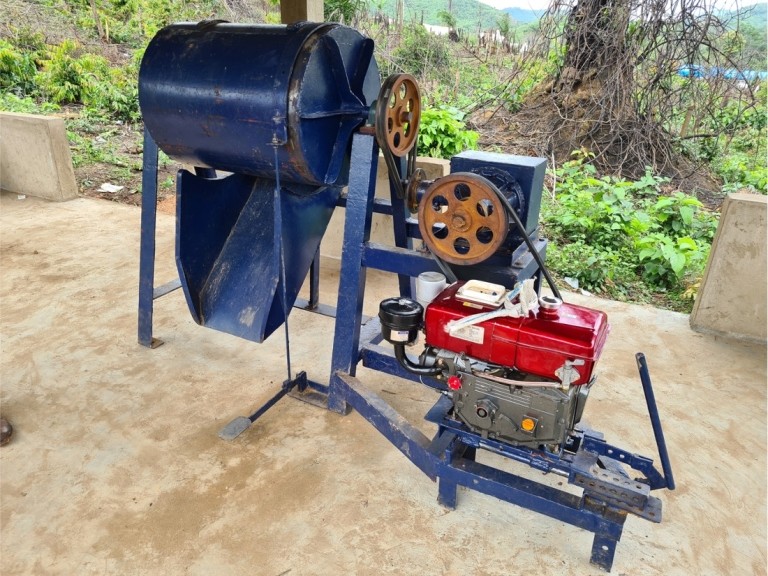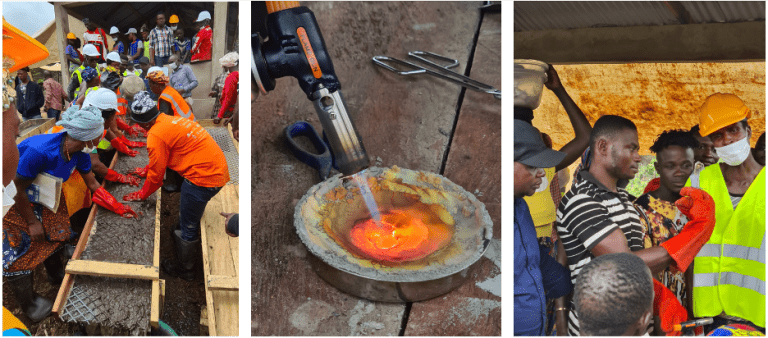Blog
Ongoing capacity development toward local solutions for formal, mercury-free gold

When Pact began working with artisanal gold miners in Sierra Leone’s Tonkolili district, we had two main objectives: supporting them in formalizing their livelihoods, and in producing mercury-free gold. Less than two years later, hand in hand with the community, we have realized both milestones – although ongoing support is needed for sustaining them.
This is part of our Piloting NAP Implementation in Sierra Leone project, financed by BMZ through GIZ, which seeks to support the Sierra Leonian Government in implementing its National Action Plan (NAP) for reducing mercury use in the country’s growing artisanal and small-scale gold mining (ASGM) sector, which I had the opportunity to co-develop.
Since the start of the project, Pact has helped the community in Bolaneh to navigate the tedious formalization process, which we view as a process of ongoing capacity development. With our guidance, a hardworking group of miners and traders has for example registered with the Tonkolili District Council as the country’s first formal ASGM association, the Bolaneh Gold Miners and Traders Association (BMTA).
As shared in a previous blog, we supported the association in the acquisition of land rights, mining licenses, the development of a constitution and opening of a bank account.
We now have exciting new progress to share. In terms of formalization, we worked in partnership with BMTA’s leadership through bi-monthly visits – led by our national coordinator, Joseph Smith – focused on issues of business management, strengthening of executive functions, ensuring compliance with national regulations, and evaluating and managing legal, social and environmental risks. These periodic visits, which include a review with BMTA members on progress made on agreed tasks and an identification of new actions based on their own views, have helped to yield concrete socio-economic benefits.
For example, as BMTA’s vice-chair shared in a recent community meeting (translated from Krio):
“In the past, the men in this community were not allowing women to own mining pits along the Bolaneh mining trench. But with the Pact project, we the women can now own pits along the trench.” (During the mentioned discussions, it was agreed to allocate at least one pit to BMTA’s women members.) “Although we have been hearing about the phrase ‘gender equality’, Pact has helped us to know what actually ‘gender equality’ is.”
Other important social achievements relate to child labor in Bolaneh. Throughout 2021, multiple children were observed descending in the community’s mine trench, exposing them to severe health and safety risks. But following Pact and BMTA’s periodic discussions on risk management, its members have been sensitizing community members on this topic. Since May 2022, no children have been observed in the trench – though we will continue monitoring this.
All risk evaluation and management has been reported in Pact and BMTA’s ‘CRAFT Scheme’, which now demonstrates compliance with international standards such as the OECD Due Diligence Guidance and the EU Regulation on Conflict Minerals. To ensure ongoing improvements, Pact also helped BMTA develop a ‘Mine Business Plan’, which includes the association’s business model and outlines actions for improving environmental and health issues across the mine life cycle, although further funding is needed for implementing all of the plan.
In terms of mercury reduction, Pact also focused on local solutions. Although it takes time and effort to achieve the desired quality and suitability of new equipment, ‘local content’ is high on Sierra Leone’s development agenda, and we wanted to leverage the talent of local craftsmen in a mining country that still imports most of its equipment from abroad. Pact engaged a local construction firm named GibsCon and a local fabricator named Formal Industries and National Industrialization Center (FINIC) to build a mercury-free mineral processing facility with BMTA in Bolaneh.
In short, since our geological assessments and laboratory tests found that Bolaneh’s gold is very fine, we realized that we need to invest in fine milling to ‘liberate’ the gold from its host rock if mercury use is to be avoided. Drawing inspiration from small-scale ball mills used by ASGM operators in countries such as Tanzania and Kenya, we have worked with FINIC to produce a small-scale, relatively affordable ‘ball mill’.

The ball mill can be used after the ore has been crushed in a jaw crusher, to produce very fine ore. For concentrating this fine ore, we have worked with technicians in Magboraka town to improve the ‘sluice boxes’ currently used in Sierra Leone, such as by equipping them with ‘miners moss’ and a wire mesh which helps to better capture gold particles in the sluicing process.
While we are waiting for some equipment to be introduced in September, we have already produced mercury-free gold with BMTA. During a live demonstration on July 27, which was attended by local authorities such as the Environment Protection Agency, the National Minerals Agency and the Paramount Chief of Kafe chiefdom and GIZ, and which was part of a larger multiple-day training that Pact delivered to 124 project participants, we successfully trialed a ‘cupellation’ process to purify concentrated ore and obtain a mercury-free gold button.

Encouraged by this successful first trial using local solutions, Pact, FINIC and BMTA are currently completing the procurement of an advanced jaw crusher and a ‘direct smelting’ set, which have been fabricated but are still being fine-tuned to optimize their safe use by BMTA. This is expected to be completed in September, when Pact and FINIC are scheduled to return to Bolaneh for installing and trialing this final batch of equipment with BMTA’s Equipment Management Committee which is mandated to manage the equal access to and proper maintenance of the equipment.
Want to learn more? Read the project’s August Bulletin and watch for a forthcoming video presenting the project’s full mercury-free mineral processing plant.